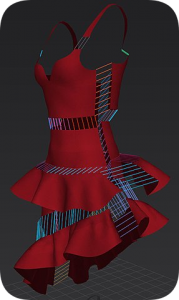 Yesterday, we looked at how video game companies earn billions of dollars annually by selling virtual products to an ever-growing market. Inspired by the success of this unusual industry, some clothing companies have started selling digital outfits that don’t exist in the real world. For instance, the fashion label The Fabricant recently sold a virtual dress for $9,500 to the wife of a San Francisco tech executive. Although she cannot actually put on her expensive new outfit, she can Photoshop it onto an existing picture and post it to social media for her followers to admire.
Yesterday, we looked at how video game companies earn billions of dollars annually by selling virtual products to an ever-growing market. Inspired by the success of this unusual industry, some clothing companies have started selling digital outfits that don’t exist in the real world. For instance, the fashion label The Fabricant recently sold a virtual dress for $9,500 to the wife of a San Francisco tech executive. Although she cannot actually put on her expensive new outfit, she can Photoshop it onto an existing picture and post it to social media for her followers to admire.
Another company called Carlings launched a digital clothing line in October that “sold out” within a month. “It sounds kinda stupid to say we ‘sold out’, which is theoretically impossible when you work with a digital collection because you can create as many as you want,” said Ronny Mikalsen, the Scandanavian company’s brand director. “We had set a limit on the amount of products we were going to produce to make it a bit more special.” Along with creating scarcity, Carlings also made its digital designs as colorful and exciting as possible. “You wouldn’t buy a white t-shirt digitally, right? Because it makes no sense showing it off,” said Mikalsen. “So it has to be something that you really either want to show off, or an item that you wouldn’t dare to buy physically, or you couldn’t afford to buy physically.”
Carlings originally unveiled its digital line as a marketing campaign for clothes that people can physically wear. Given the success of its first virtual offerings, however, the company plans to release another line of digital items towards the end of the year. Of course, this emerging market is still very much in its infancy: Carlings has only sold a total of about 250 virtual items. Meanwhile, The Fabricant admits that most of its current clientele are industry professionals who are curious about digital fashion. Customers must be skilled at altering photos in order to put on their virtual clothes, creating a barrier of entry to many regular consumers. So while digital items are largely a niche product right now, experts expect they could have a major impact in the long term. “Digital fashion will become an important part of every fashion business’ future business model,” said Matthew Drinkwater of the Fashion Innovation Agency. “It’s not going to replace everything, but it will be an important part of that.”
Questions:
- Why did Carlings set a limit on the amount of virtual items it released in October? What are the benefits of this strategy?
- Do you think virtual clothing will eventually grow into an important part of the fashion industry? Why or why not?
Source: Cody Godwin, “The £7,500 Dress That Does Not Exist,” BBC, November 15, 2019. Photo by WandaWonders.
